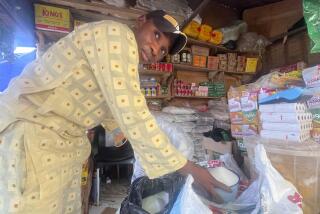Cocoa, coffee give investors a buzz
- Share via
In the U.S., the true comfort foods are chocolate and coffee -- which may provide relief for investors battered by plummeting prices for oil, gold, wheat and other products.
The prices of most commodities have tumbled this year as recession has spread around the globe, hammering consumer demand for the raw materials that go into a loaf of bread, your car’s gas tank and much more.
But cocoa and, to an extent, coffee have bucked that trend, and some analysts think they can keep doing so.
While oil prices have plunged 51% this year and wheat prices are off 41%, coffee -- currently trading at around $1.10 a pound -- has fallen a comparatively modest 17% in the futures markets, according to Brad Zigler, managing editor of HardAssetInvestor.com in Santa Rosa, Calif.
And cocoa prices, now at $2,372 a metric ton, are actually up 15% for the year.
“This is the only good news we can find” now in commodities, said Mark Hansen, director of trading at CPM Group.
Historically, coffee consumption tends to hold up well during hard economic times, Hansen said. What changes is where it’s consumed.
“Instead of going to Starbucks, you buy the 2-pound drum of Maxwell House and make it at home,” he said.
That isn’t good news for Starbucks, which is closing stores amid declining sales, but it is a positive for the market overall and could help put a floor under coffee prices, Hansen said.
In a report last month, Zigler noted that coffee consumption rose an average of 2.2% during recent recessions.
Zigler estimates that an 8-ounce cup of joe brewed at home with Folgers from the local grocery store costs less than a quarter. A 12-ounce (“tall”) cup of Pike Place Roast at Starbucks runs $1.25.
Hansen and Zigler also note that coffee supplies are tight, the result of the frozen credit markets’ making it tough for growers to finance purchases of fertilizer and pesticides. Coffee inventories in Brazil, the world’s biggest producer, are at 50-year lows, officials estimate.
The outlook for cocoa prices is more semisweet than sweet for sellers of the beans.
Chocolate sales appear to be holding up pretty well in the face of economic hard times, but that could change if things get markedly worse. In particular, sales of pricier dark chocolate -- which uses a much higher percentage of cocoa than milk chocolate -- could melt along with the economy.
--
More to Read
Inside the business of entertainment
The Wide Shot brings you news, analysis and insights on everything from streaming wars to production — and what it all means for the future.
You may occasionally receive promotional content from the Los Angeles Times.








